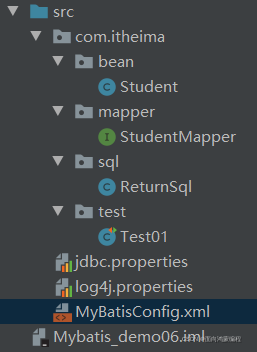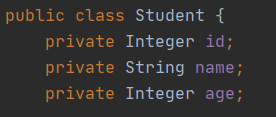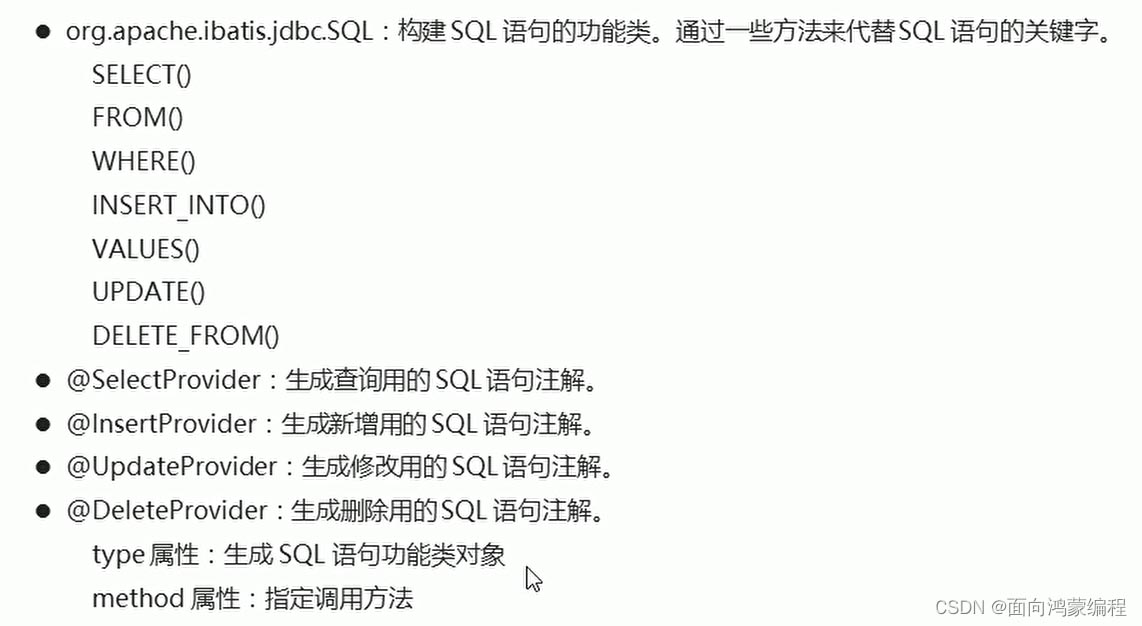Mybatis如何构建SQL语句
作者:金鳞踏雨
这篇文章主要介绍了Mybatis如何构建SQL语句问题,具有很好的参考价值,希望对大家有所帮助,如有错误或未考虑完全的地方,望不吝赐教
SQL构建对象介绍
我们之前通过注解开发时,相关 SQL 语句都是自己直接拼写的。
一些关键字写起来比较麻烦、而且容易出错。
MyBatis 给我们提供了 org.apache.ibatis.jdbc.SQL 功能类,专门用于构建 SQL 语句。

就是使用方法调用来代替之前繁琐的SQL编写。
我们来使用一下Mybatis提供的SQL功能类
package com.itheima.sql;
import org.apache.ibatis.jdbc.SQL;
public class sqlTest {
public static void main(String[] args) {
String sql = getSql();
System.out.println(sql);
// 输出
// SELECT *
// FROM student
}
public static String getSql() {
String sql = new SQL() {
{
SELECT("*");
FROM("student");
}
}.toString();
return sql;
}
}我们可以查看一下SQL功能类
package org.apache.ibatis.jdbc;
public class SQL extends AbstractSQL<SQL> {
public SQL() {
}
public SQL getSelf() {
return this;
}
}再查看一下它的父类

显然,这些大家都应该很熟悉,都是SQL中的关键字,使用SQL功能类,可以降低在开发中的出错率。
查询功能的实现
定义功能类并提供获取查询的 SQL 语句的方法。
@SelectProvider:生成查询用的 SQL 语句注解。
- type 属性:生成 SQL 语句功能类对象
- method 属性:指定调用方法
ReturnSql类
这里面创建SQL的功能类
public class ReturnSql {
// 定义方法,返回用来查询的SQL语句
public String getSelectAll() {
return new SQL() {
{
SELECT("*");
FROM("student");
}
}.toString();
}
}StudentMapper类
public interface StudentMapper {
// 查询全部
//@Select("SELECT * FROM student")
@SelectProvider(type = ReturnSql.class, method = "getSelectAll")
public abstract List<Student> selectAll();
};这里的type的值就是生成 SQL 语句功能类对象——ReturnSql,method的值就是功能类中的方法
——getSelectAll
Test类
public class Test01 {
@Test
public void selectAll() throws IOException {
// 1.加载核心配置文件
InputStream is = Resources.getResourceAsStream("MyBatisConfig.xml");
// 2.获取SqlSession工厂对象
SqlSessionFactory sqlSessionFactory = new SqlSessionFactoryBuilder().build(is);
// 3.通过工厂对象获取SqlSession对象
SqlSession sqlSession = sqlSessionFactory.openSession(true);
// 4.获取StudentMapper接口的实现类对象
// 通过StudentMapper的字节对象 来得到实现类对象
StudentMapper mapper = sqlSession.getMapper(StudentMapper.class);
// 5.调用实现类对象中的方法
List<Student> list = mapper.selectAll();
// 6.处理结果
for (Student student : list) {
System.out.println(student);
}
// 7.释放资源
sqlSession.close();
is.close();
}
}
新增、修改、删除功能的实现
其实这些都是大同小异,比起之前的Mybatis框架前面的学习不值一提,只要调用函数就可以实现。
- @InsertProvider:生成新增用的 SQL 语句注解。
- @UpdateProvider:生成修改用的 SQL 语句注解。
- @DeleteProvider:生成删除用的 SQL 语句注解。
完整代码展现
项目骨架

bean包下的Student类

映射配置文件StudentMapper接口
我们使用注解的方式将SQL工具类引入
public interface StudentMapper {
// 查询全部
//@Select("SELECT * FROM student")
@SelectProvider(type = ReturnSql.class, method = "getSelectAll")
public abstract List<Student> selectAll();
// 新增操作
//@Insert("INSERT INTO student VALUES (#{id},#{name},#{age})")
@InsertProvider(type = ReturnSql.class, method = "getInsert")
public abstract Integer insert(Student stu);
// 修改操作
//@Update("UPDATE student SET name=#{name},age=#{age} WHERE id=#{id}")
@UpdateProvider(type = ReturnSql.class, method = "getUpdate")
public abstract Integer update(Student stu);
// 删除操作
//@Delete("DELETE FROM student WHERE id=#{id}")
@DeleteProvider(type = ReturnSql.class, method = "getDelete")
public abstract Integer delete(Integer id);
}sql包下的ReturnSql类
里面编写了SQL功能类
public class ReturnSql {
// 定义方法,返回用来查询的SQL语句
public String getSelectAll() {
return new SQL() {
{
SELECT("*");
FROM("student");
}
}.toString();
}
public String getInsert(Student stu) {
return new SQL() {
{
INSERT_INTO("student");
INTO_VALUES("#{id},#{name},#{age}");
}
}.toString();
}
public String getUpdate(Student stu) {
return new SQL() {
{
UPDATE("student");
SET("name=#{name}","age=#{age}");
WHERE("id=#{id}");
}
}.toString();
}
public String getDelete(Integer id) {
return new SQL() {
{
DELETE_FROM("student");
WHERE("id=#{id}");
}
}.toString();
}
}测试方法
package com.itheima.test;
import com.itheima.bean.Student;
import com.itheima.mapper.StudentMapper;
import org.apache.ibatis.io.Resources;
import org.apache.ibatis.session.SqlSession;
import org.apache.ibatis.session.SqlSessionFactory;
import org.apache.ibatis.session.SqlSessionFactoryBuilder;
import org.junit.Test;
import java.io.IOException;
import java.io.InputStream;
import java.util.List;
public class Test01 {
@Test
public void selectAll() throws IOException {
// 1.加载核心配置文件
InputStream is = Resources.getResourceAsStream("MyBatisConfig.xml");
// 2.获取SqlSession工厂对象
SqlSessionFactory sqlSessionFactory = new SqlSessionFactoryBuilder().build(is);
// 3.通过工厂对象获取SqlSession对象
SqlSession sqlSession = sqlSessionFactory.openSession(true);
// 4.获取StudentMapper接口的实现类对象
// 通过StudentMapper的字节对象 来得到实现类对象
StudentMapper mapper = sqlSession.getMapper(StudentMapper.class);
// 5.调用实现类对象中的方法
List<Student> list = mapper.selectAll();
// 6.处理结果
for (Student student : list) {
System.out.println(student);
}
// 7.释放资源
sqlSession.close();
is.close();
}
@Test
public void insert() throws IOException {
// 1.加载核心配置文件
InputStream is = Resources.getResourceAsStream("MyBatisConfig.xml");
// 2.获取SqlSession工厂对象
SqlSessionFactory sqlSessionFactory = new SqlSessionFactoryBuilder().build(is);
// 3.通过工厂对象获取SqlSession对象
SqlSession sqlSession = sqlSessionFactory.openSession(true);
// 4.获取StudentMapper接口的实现类对象
// 通过StudentMapper的字节对象 来得到实现类对象
StudentMapper mapper = sqlSession.getMapper(StudentMapper.class);
// 5.调用实现类对象中的方法
Student stu = new Student(9,"张九",90);
Integer result = mapper.insert(stu);
// 6.处理结果
System.out.println(result);
// 7.释放资源
sqlSession.close();
is.close();
}
@Test
public void update() throws IOException {
// 1.加载核心配置文件
InputStream is = Resources.getResourceAsStream("MyBatisConfig.xml");
// 2.获取SqlSession工厂对象
SqlSessionFactory sqlSessionFactory = new SqlSessionFactoryBuilder().build(is);
// 3.通过工厂对象获取SqlSession对象
SqlSession sqlSession = sqlSessionFactory.openSession(true);
// 4.获取StudentMapper接口的实现类对象
// 通过StudentMapper的字节对象 来得到实现类对象
StudentMapper mapper = sqlSession.getMapper(StudentMapper.class);
// 5.调用实现类对象中的方法
Student stu = new Student(9,"张九",1000);
Integer result = mapper.update(stu);
// 6.处理结果
System.out.println(result);
// 7.释放资源
sqlSession.close();
is.close();
}
@Test
public void delete() throws IOException {
// 1.加载核心配置文件
InputStream is = Resources.getResourceAsStream("MyBatisConfig.xml");
// 2.获取SqlSession工厂对象
SqlSessionFactory sqlSessionFactory = new SqlSessionFactoryBuilder().build(is);
// 3.通过工厂对象获取SqlSession对象
SqlSession sqlSession = sqlSessionFactory.openSession(true);
// 4.获取StudentMapper接口的实现类对象
// 通过StudentMapper的字节对象 来得到实现类对象
StudentMapper mapper = sqlSession.getMapper(StudentMapper.class);
// 5.调用实现类对象中的方法
Integer result = mapper.delete(9);
// 6.处理结果
System.out.println(result);
// 7.释放资源
sqlSession.close();
is.close();
}
}随便附上核心配置文件MyBatisConfig.xml
<?xml version="1.0" encoding="UTF-8" ?>
<!DOCTYPE configuration
PUBLIC "-//mybatis.org//DTD Config 3.0//EN"
"http://mybatis.org/dtd/mybatis-3-config.dtd">
<!--configuration 核心根标签-->
<configuration>
<!-- 引入数据库连接的配置文件 -->
<properties resource="jdbc.properties"/>
<!-- 配置log4j -->
<settings>
<setting name="logImpl" value="log4j"/>
</settings>
<!-- 使用通用的配置方式起别名 ,别名默认是类名 -->
<typeAliases>
<package name="com.itheima.bean"/>
</typeAliases>
<!--environments配置数据库环境,环境可以有多个。default属性指定使用的是哪个-->
<environments default="mysql">
<!--environment配置数据库环境 id属性唯一标识-->
<environment id="mysql">
<!-- transactionManager事务管理。 type属性,采用JDBC默认的事务-->
<transactionManager type="JDBC"/>
<!-- dataSource数据源信息 type属性 连接池-->
<dataSource type="POOLED">
<!-- property获取数据库连接的配置信息 -->
<property name="driver" value="${driver}" />
<property name="url" value="${url}" />
<property name="username" value="${username}" />
<property name="password" value="${password}" />
</dataSource>
</environment>
</environments>
<!-- mappers引入映射配置文件 -->
<mappers>
<!-- mapper 引入指定的映射配置文件 resource属性指定映射配置文件的名称 -->
<!-- package 的name属性用来指定包的路径-->
<package name="com.itheima.mapper"/>
</mappers>
</configuration>
总结

以上为个人经验,希望能给大家一个参考,也希望大家多多支持脚本之家。
